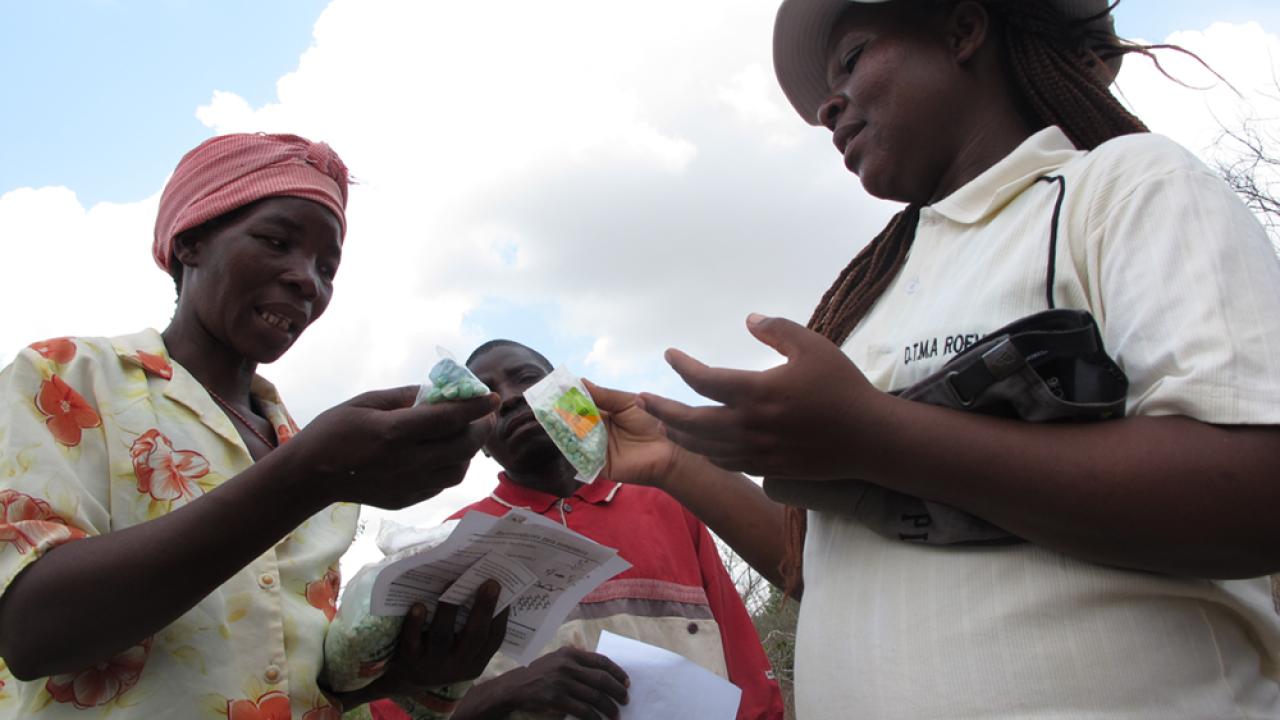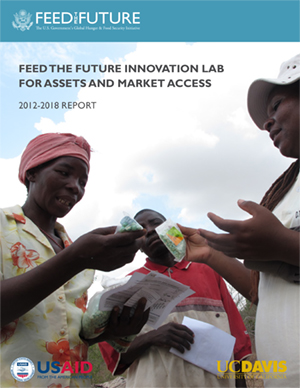
In 2001, the research network that would become the AMA Innovation Lab began a series of programs in eastern and southern Africa to explore the nature of chronic and persistent poverty. The approach generated a foundational theory in two parts. First, households’ levels of assets, meaning the resources that produce a livelihood, are better predictors of chronic poverty than income. Second, when those assets fall below a minimum threshold—perhaps because of a shock—people become trapped in chronic poverty with no pathway to resilience.

In 2012 the AMA Innovation Lab was established by the USAID Bureau for Food Security as a Collaborative Research Support Program (CRSP) at the University of California, Davis to conduct rigorous policy and programming research in the areas of Inclusive Market Access, Risk Management and Resilience, and Rural and Agricultural Finance. As we found new opportunities with additional funding through USAID Associate Awards and ongoing initiatives like our Index Insurance Innovation Initiative (I4), we have expanded our efforts to respond to the broad shift in the field of development toward resilience and achieving an end to the need for development aid. Both of these are ideas that have always been at the core of our thinking.
The foundational theory and knowledge we gained from our earlier work on the dynamics of poverty and resilience has been the driving force behind our research this past six years. We have conducted basic research, program evaluations and low-cost pilots to test innovations in 32 projects across 16 countries. Our network of Principal Investigators from leading institutions worldwide have used established and cutting-edge research methods that include randomized controlled trials, digital innovations, satellite technology, advanced qualitative analysis and machine learning to expand our understanding and test what’s possible for small-scale agricultural households globally.
Our work has yielded valuable knowledge and innovations ready right now to take from the lab to the field. We can focus these results into three key categories of insights for sustainable development and resilience.
Resilience Dynamics
Our work on poverty dynamics has established three fundamental and complementary pathways into and out of poverty: assets, capacities and risk. Our field trials around the world have contributed significantly to our understanding of these dynamics and provided the opportunity to design and evaluate programs intended to reduce poverty and promote resilience.
In the broadest sense, ending the need for development aid will depend on our ability to continually shrink the number of poor households over time. While cash transfers sustain the very poorest households in times of dire need, we could achieve much bigger long-term impacts from a contingent transfer—such as agricultural insurance—that keeps vulnerable households from falling into poverty. This phenomenon, which we have called the “social protection paradox,” presents a real opportunity for promoting resilience when scaled to national social protection budgets, particularly for countries in Sub-Saharan Africa and others that face a growing threat of weather-related shocks.
While the policy focus is often on assets, research shows that stress, depression or a deterioration in physical health can affect cognitive function, resulting in hardship that itself reinforces stress and depression. In the development context, this kind of self-reinforcing loop—effectively a behavioral poverty trap—means that the experience of poverty itself can influence an individual’s future decisions about productivity.
The dynamics of assets, capacities and risk mean that for small-scale agricultural households to sustainably escape poverty requires a way to increase their assets and/or capacities while managing or transferring their risks. Ideally, programs will accomplish all three. Poverty graduation programs, which increase assets and capacities, provide a unique opportunity to test the dynamics of poverty and resilience when agricultural insurance is added.
Risk and Insurance
The risk of weather-related catastrophes, illness or market failures creates challenges for agricultural households in two ways. First, poverty often starts with a serious shock. However, risk itself can discourage households from investing in more productive technologies or cash crops. Agricultural insurance is a key tool for promoting resilience as both a safety net in bad years and a way to promote investments for a higher income in the good.
We must be sure index insurance works as theorized and that the impacts are high. We have contributed to a growing base of evidence that high-quality index insurance does act as an effective safety net, keeping households from selling off assets or reducing consumption after a weather-related catastrophe. We have also established that index insurance promotes investments in more productive technologies and cash crops with a potential to increase profitability.
Low-quality contracts have the potential to leave households who purchase them worse off than having no insurance at all. The AMA Innovation Lab has developed a Minimum Quality Standard for agricultural index insurance (MQS), the world’s first objective measure of index insurance quality. Right now MQS is at the center of a USAID/UC Davis initiative to launch the world’s first index insurance quality certification in East Africa.
Advances in satellite technology and index insurance contract innovations are key pathways for reducing “basis risk,” meaning the likelihood that a contract will pay out accurately for losses. The AMA Innovation Lab has leveraged advances in satellite technology to improve how well an index can predict losses for individual farmers. We have developed and tested a number of contract innovations, including an audit rule and a dual-strikepoint contract, both of which are ready for broad adoption and scaling.
Bundling index insurance with existing interventions, both for microfinance and weather-related risk, are particularly promising. Village Insurance Savings Accounts (VISA) use savings groups to aggregate small insurance purchases into one larger purchase, which makes offering insurance contracts more feasible in remote, rural communities. We are also testing how bundling index insurance with drought-tolerant seed can eliminate the risk of hybrid adoption and boost yields in years without drought.
Inclusive Agricultural Growth
Farmers have not adopted many of the technologies which have seen the greatest investments—like hybrid seeds and chemical fertilizers—in part because of their higher risk in an unpredictable environment. Constraints include thin markets for credit and inputs, but access to information is also a fundamental barrier to adopting more productive technologies.
AMA Innovation Lab research has established that temporary subsidies eliminate a key constraint to adoption by reducing the risk of trying a new input. They also provide a low-risk way to learn whether new inputs or farming methods are profitable. In addition to promoting technology adoption, a temporary subsidy could shift broader poverty dynamics by increasing a farmer’s future planning as well as what they believe to be their economic prospects.
Our projects have also shown that significant agro-ecological variation between small-scale farms, including soil variation, microclimates and other physical conditions, can significantly affect yields and even whether improved inputs are profitable. High variation within villages can also severely hinder what households can learn from their neighbors. When farmers learn from each other’s experiences, they avoid costly experimentation with new inputs.
The proliferation of information and communications technology across developing economies provides a primed opportunity for small-scale producers to get broader access to market information. Our researchers have developed a printed phone directory that connects rural and remote households to enterprises, strengthening local markets and reducing the costs of finding information. We have also helped to build an Online marketing platform that has shown promise in trade volumes in its second year.
AMA Innovation Lab Outreach Impact
We have worked diligently so these kinds of research results achieve the greatest impact. Part of this is ensured by the structure of our projects. The majority of our work is conducted in partnership with governments, private-sector entities, international NGOs and other stakeholders who share in the development of the intervention, participate in the process of evaluation and receive results directly. This two-way relationship provides a context for the research, access to data and rigorous analysis fit for publication under the scrutiny of peer review in leading academic publications.
Another important part of our work is dedicated outreach through dedicated stakeholder engagement and large-scale events both in the U.S. and in host countries, as well as a robust program of ongoing news media outreach, web publications and other content tailored for the broader development community. The result of these efforts include a wealth of accessible and adaptable knowledge, toolkits for scaling interventions and a wide network of stakeholders working to promote greater opportunities for small-scale agricultural households.
Looking Toward the Future
The AMA Innovation has three continuing projects supported by USAID Associate Awards that integrate the knowledge we have already gained. A project in Kenya pairs an effective poverty graduation program with an established livestock insurance program. A project in Tanzania and Mozambique is measuring the impacts of pairing drought-tolerant maize developed by CIMMYT with index insurance. The third is evaluating the impact of the PEPFAR program for orphans and vulnerable children in Mozambique.
Overall, the AMA Innovation Lab has helped to establish and cement lasting connections between people who are all working to build better opportunities for small-scale agricultural families. We must continue to find new ways to address the complex challenges facing the world’s poorest populations today and to design, target and evaluate the most effective interventions for tomorrow.
